
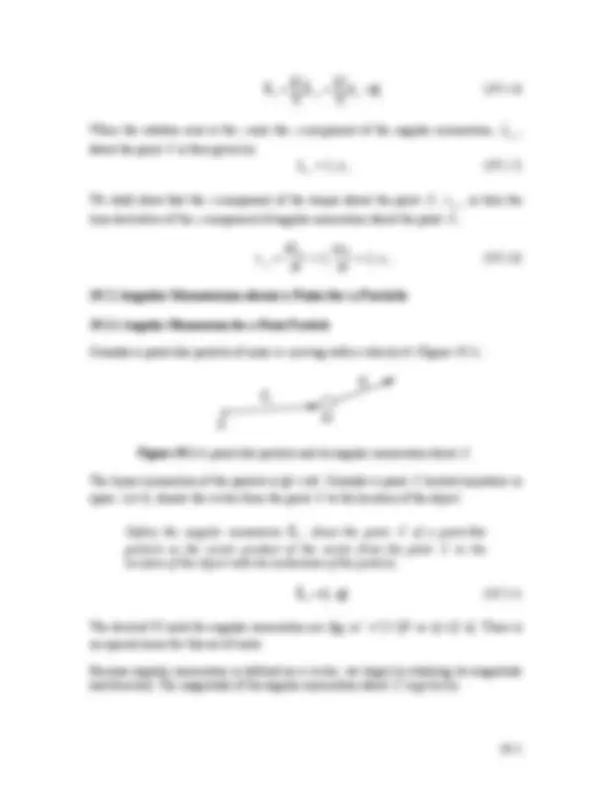
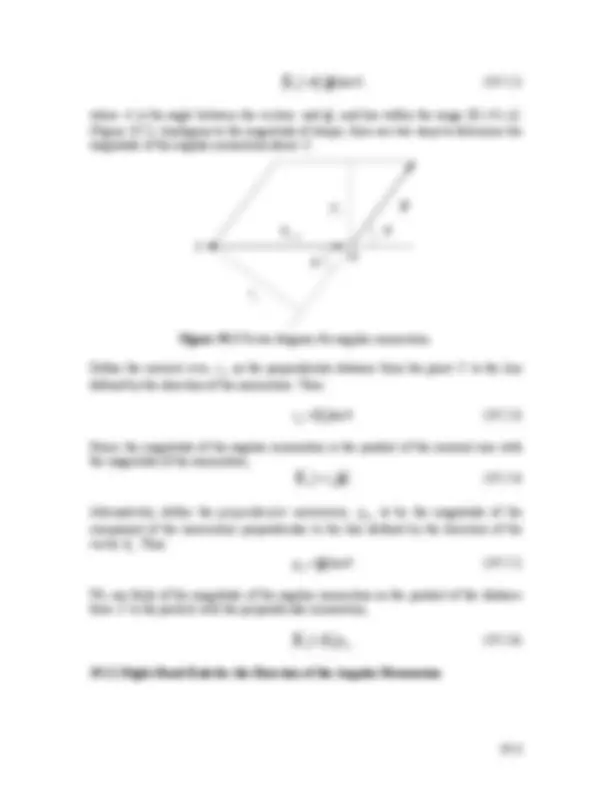
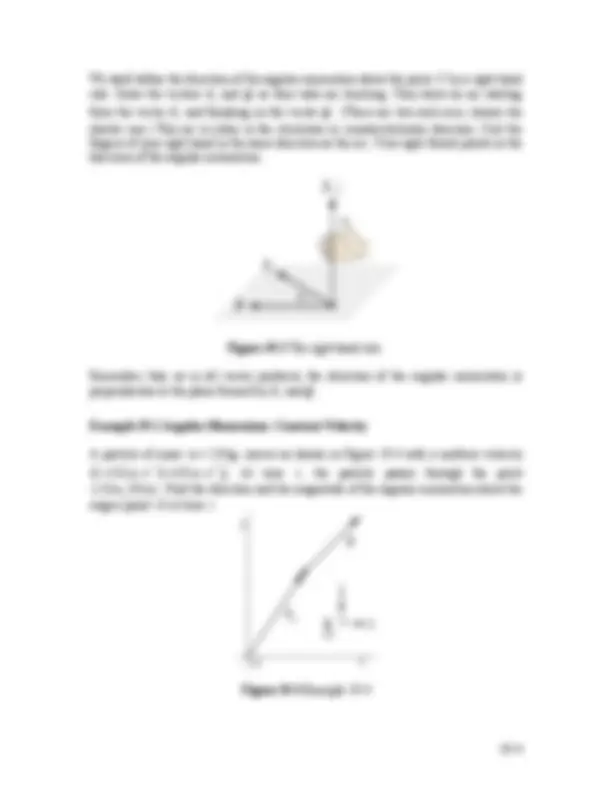
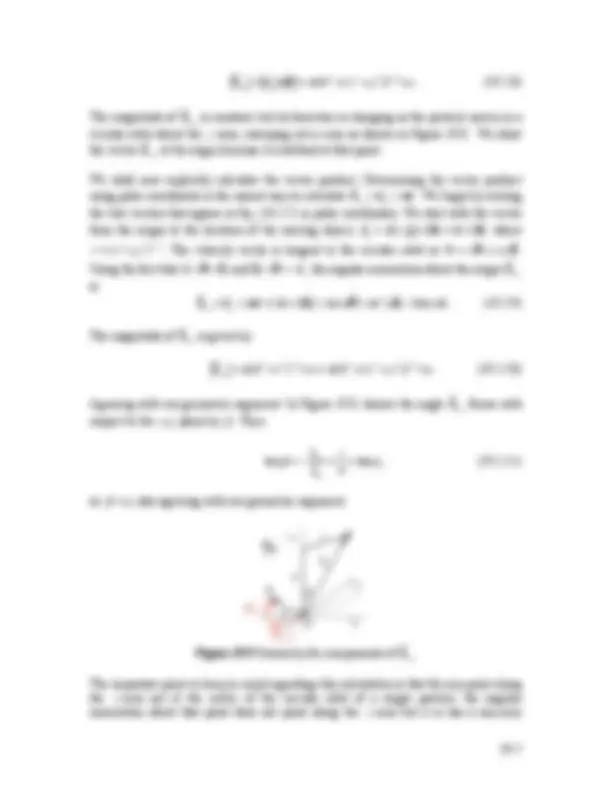
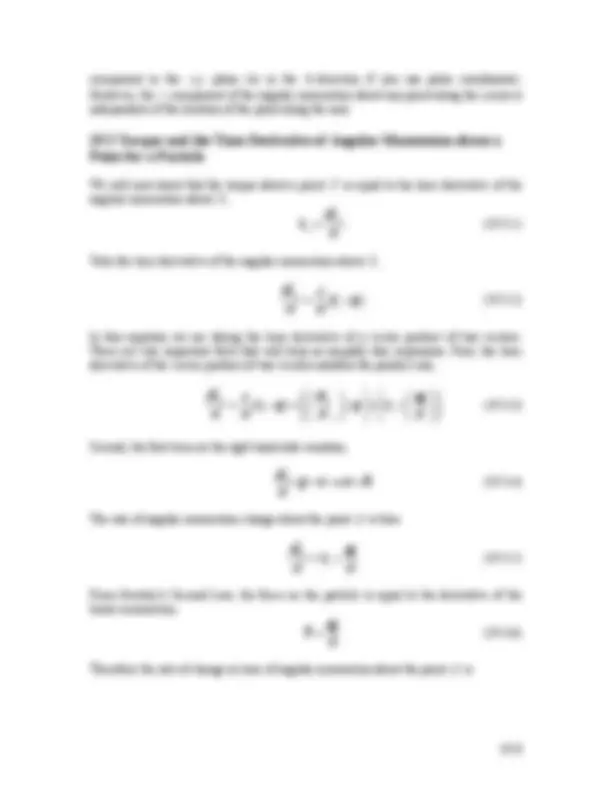
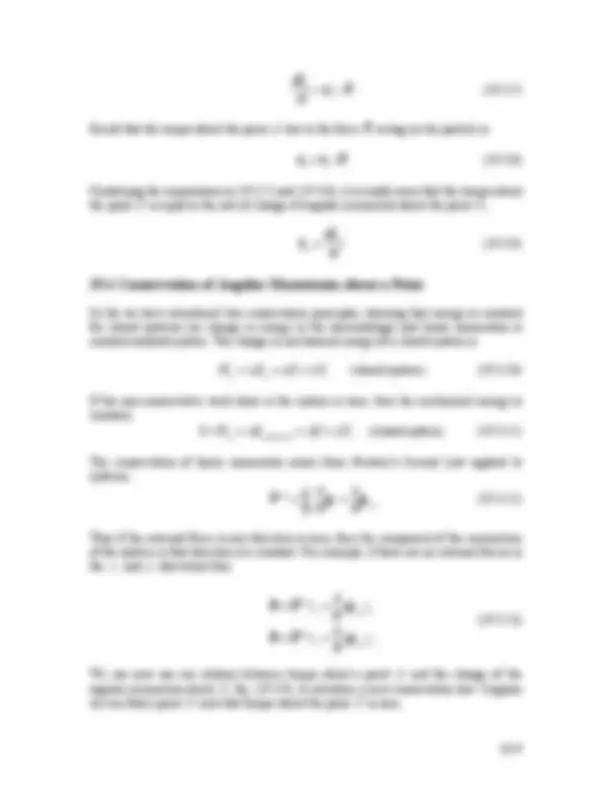
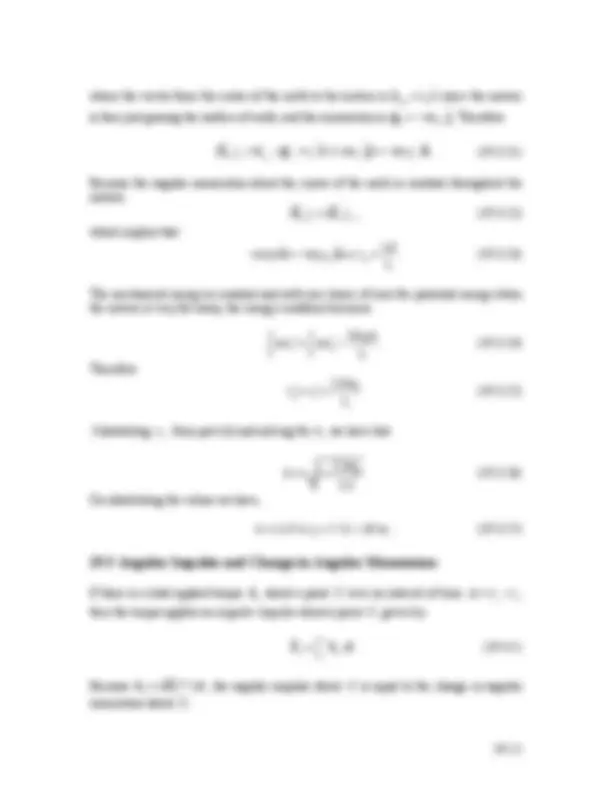
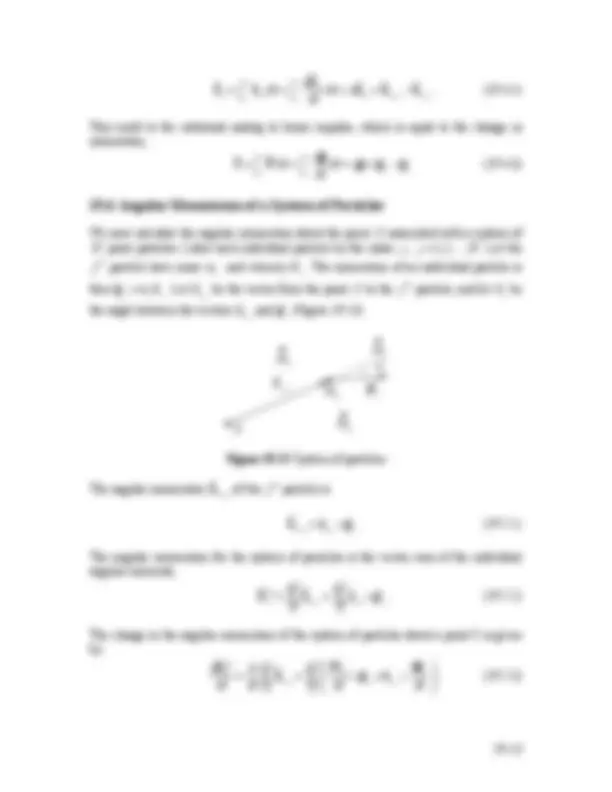
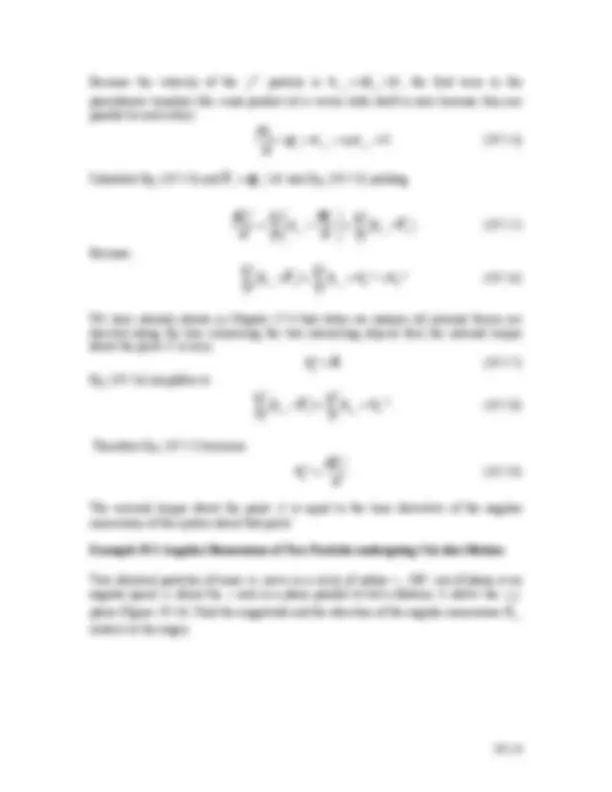
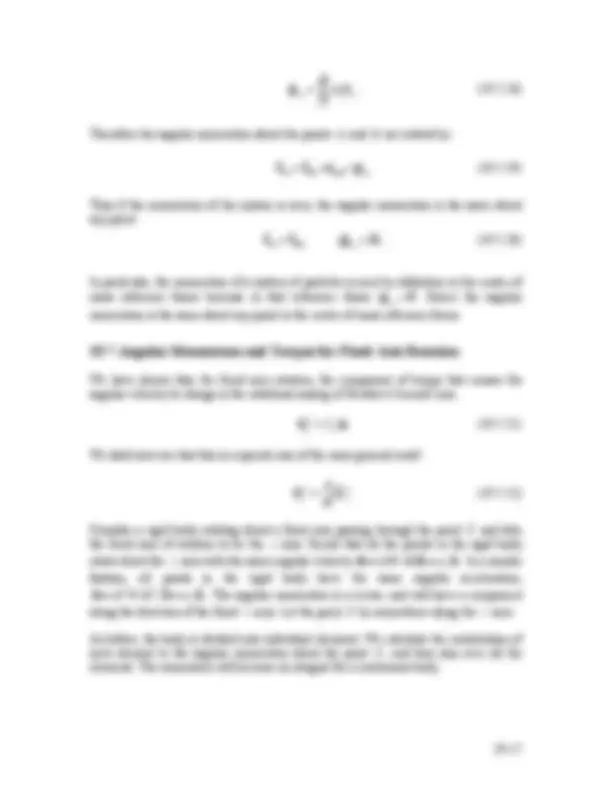
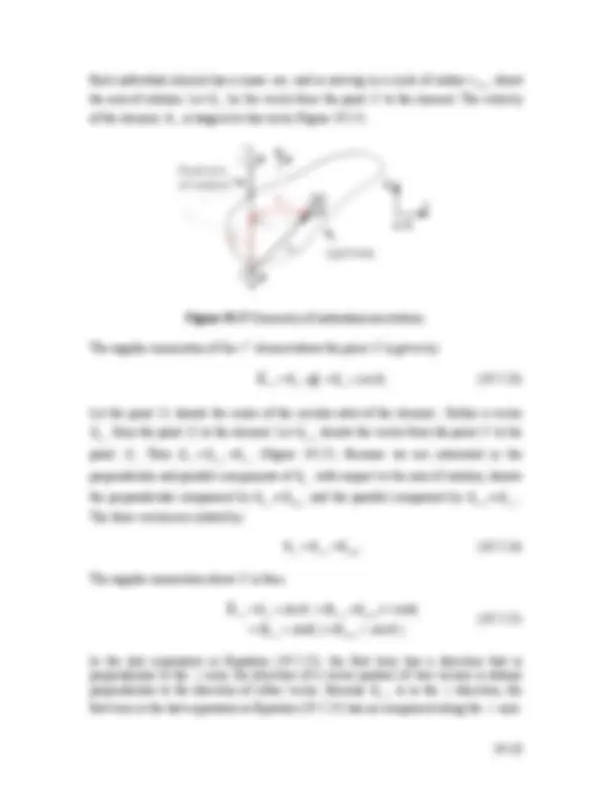
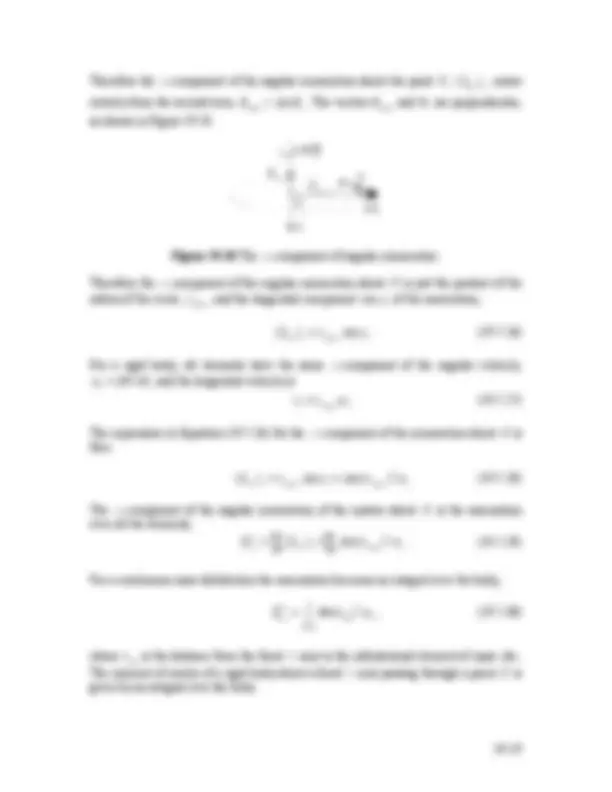
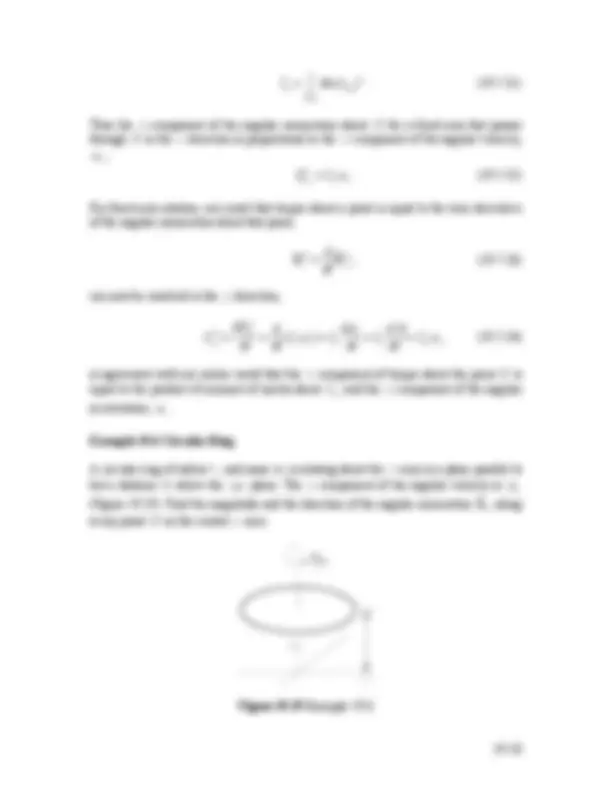
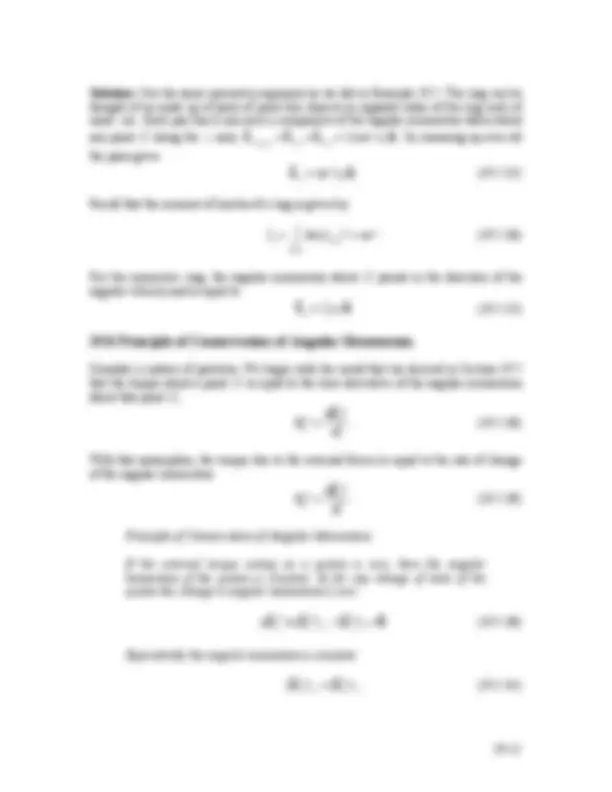
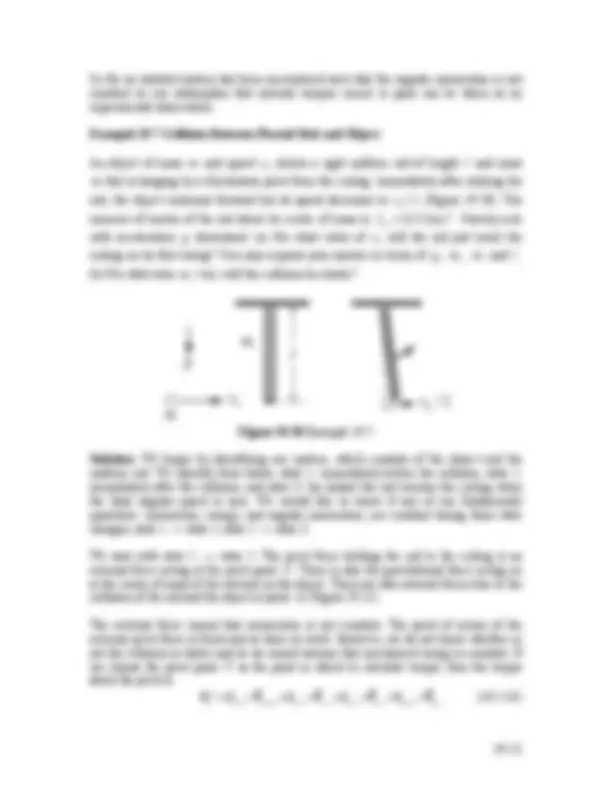
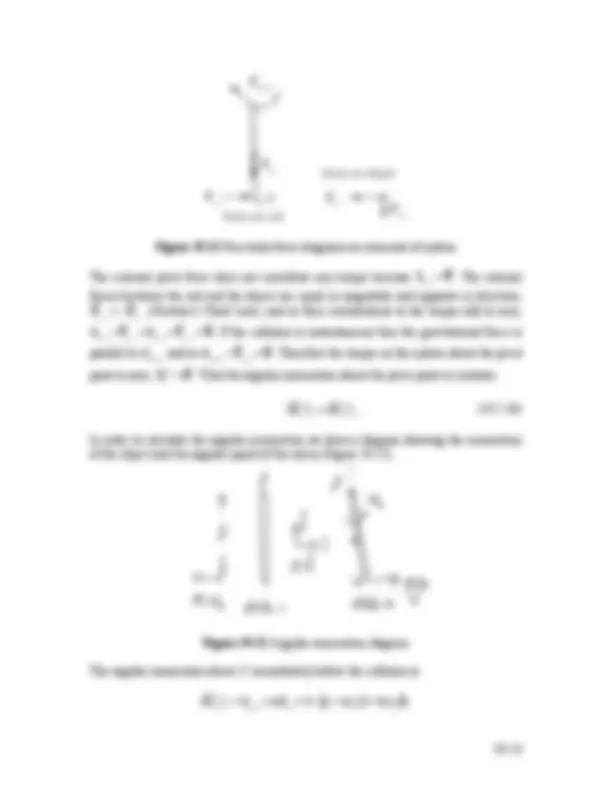
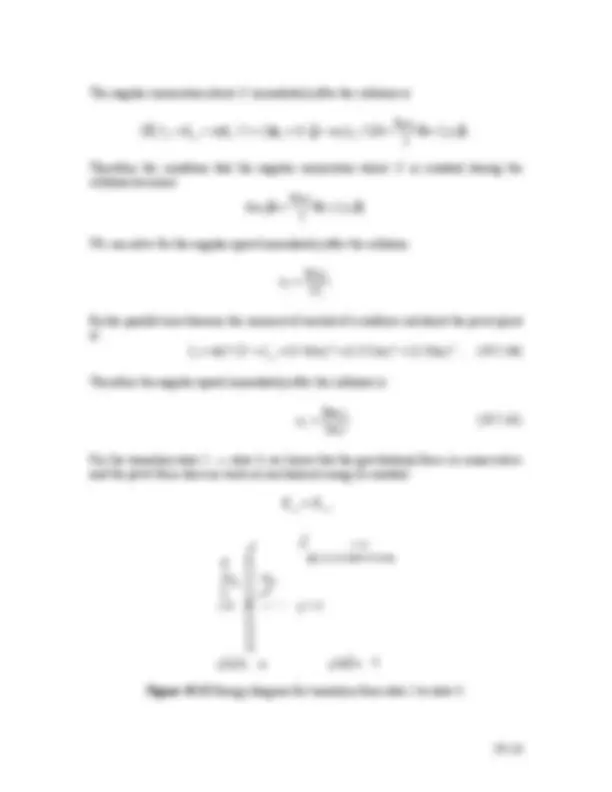
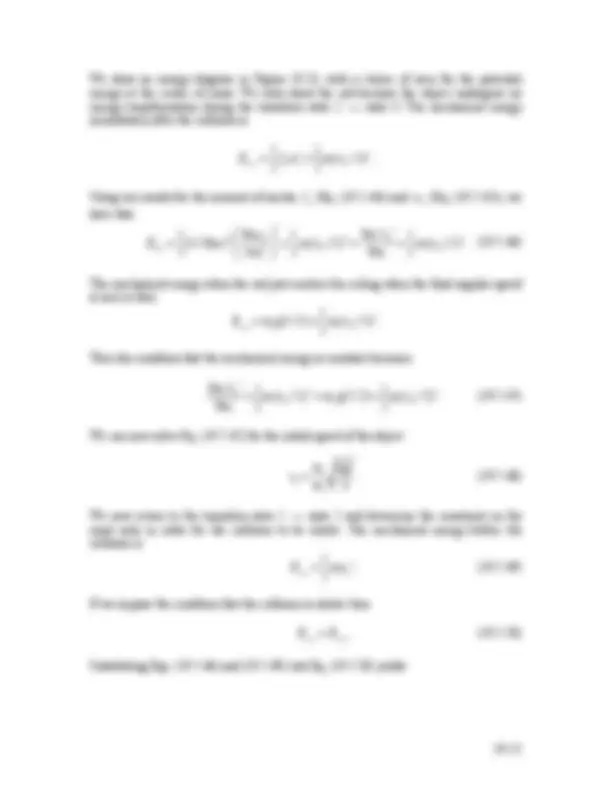
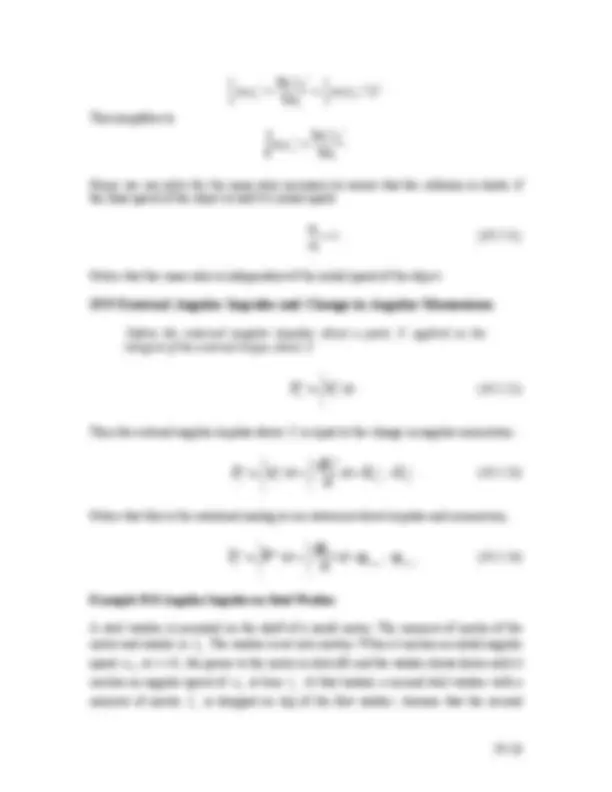
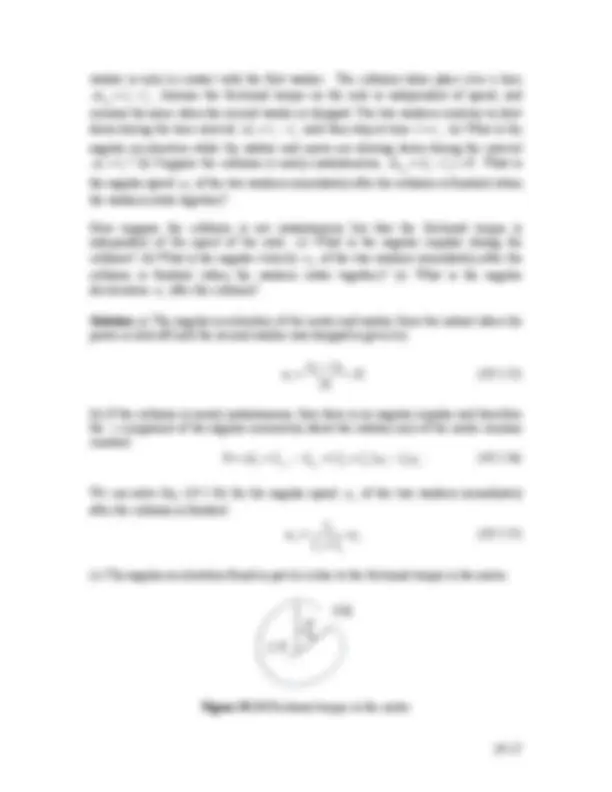
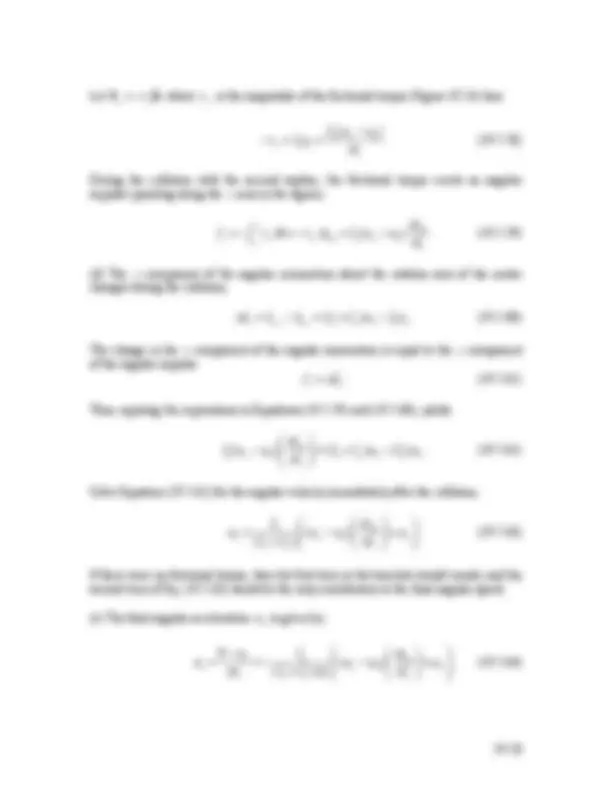


Study with the several resources on Docsity

Earn points by helping other students or get them with a premium plan


Prepare for your exams
Study with the several resources on Docsity

Earn points to download
Earn points by helping other students or get them with a premium plan
Community
Ask the community for help and clear up your study doubts
Discover the best universities in your country according to Docsity users
Free resources
Download our free guides on studying techniques, anxiety management strategies, and thesis advice from Docsity tutors
An in-depth analysis of angular momentum for a system of particles. It covers the concepts of angular momentum, torque, and their relationships. The document also discusses the conservation of angular momentum during state changes and the calculation of external angular impulses.
Typology: Study notes
1 / 29

This page cannot be seen from the preview
Don't miss anything!






















The situation, in brief, is that newtonian physics is incapable of predicting
conservation of angular momentum, but no isolated system has yet been
encountered experimentally for which angular momentum is not
conserved. We conclude that conservation of angular momentum is an
independent physical law, and until a contradiction is observed, our
physical understanding must be guided by it.
1
Dan Kleppner
When we consider a system of objects, we have shown that the external force, acting at
the center of mass of the system, is equal to the time derivative of the total momentum of
the system,
ext
=
d
p sys
dt
We now introduce the rotational analog of Equation ( 19. 1. 1 ). We will first introduce the
concept of angular momentum for a point-like particle of mass m with linear momentum
p
about a point S , defined by the equation
S
r S
p , ( 19. 1. 2 )
where S
r
is the vector from the point S to the particle. We will show in this chapter that
the torque about the point S acting on the particle is equal to the rate of change of the
angular momentum about the point S of the particle,
τ S
d
S
dt
Equation ( 19. 1. 3 ) generalizes to any body undergoing rotation.
We shall concern ourselves first with the special case of rigid body undergoing fixed axis
rotation about the z-axis with angular velocity
ω = ω z
k. We divide up the rigid body
into N elements labeled by the index i , i = 1 , 2 ,… N , the i
th
element having mass i
m
and position vector S , i
r
. The rigid body has a moment of inertia S
I about some point S
on the fixed axis, (often taken to be the z - axis, but not always) which rotates with angular
velocity
ω about this axis. The angular momentum is then the vector sum of the
individual angular momenta,
1
Kleppner, Daniel, An Introduction to Mechanics (1973), p. 307.
sin S S
L = r p θ
where θ is the angle between the vectors and p
, and lies within the range [ 0 ≤ θ ≤π]
(Figure 19.2). Analogous to the magnitude of torque, there are two ways to determine the
magnitude of the angular momentum about S.
Figure 19. 2 Vector diagram for angular momentum.
Define the moment arm , r ⊥
, as the perpendicular distance from the point S to the line
defined by the direction of the momentum. Then
r ⊥
r S
sin θ. ( 19. 2. 3 )
Hence the magnitude of the angular momentum is the product of the moment arm with
the magnitude of the momentum,
S
= r ⊥
p. ( 19. 2. 4 )
Alternatively, define the perpendicular momentum , p ⊥
, to be the magnitude of the
component of the momentum perpendicular to the line defined by the direction of the
vector
r S
. Thus
p sin θ ⊥
= p
We can think of the magnitude of the angular momentum as the product of the distance
from S to the particle with the perpendicular momentum,
S
r S
p ⊥
19.2.2 Right-Hand-Rule for the Direction of the Angular Momentum
We shall define the direction of the angular momentum about the point S by a right hand
rule. Draw the vectors S
r
and p
so their tails are touching. Then draw an arc starting
from the vector S
r
and finishing on the vector p
. (There are two such arcs; choose the
shorter one.) This arc is either in the clockwise or counterclockwise direction. Curl the
fingers of your right hand in the same direction as the arc. Your right thumb points in the
direction of the angular momentum.
Figure 19. 3 The right hand rule.
Remember that, as in all vector products, the direction of the angular momentum is
perpendicular to the plane formed by S
r
and p
Example 19.1 Angular Momentum: Constant Velocity
A particle of mass m = 2.0 kg moves as shown in Figure 19.4 with a uniform velocity
1 1 ˆ ˆ
− −
v = ⋅ i + ⋅ j
. At time t , the particle passes through the point
(2.0 m, 3 .0 m). Find the direction and the magnitude of the angular momentum about the
origin (point O ) at time t.
Figure 19.4 Example 19.
magnitude and the direction of the angular momentum
O
relative to the origin O. (b)
Find the z - component of
O
Figure 19.6 Example 19.
Solution: We begin by making a geometric argument. Suppose the particle has
coordinates ( x , y , h ). The angular momentum about the origin O is defined as
O
r O
× m
v. ( 19. 2. 7 )
The vectors
r O
and v
are perpendicular to each other so the angular momentum is
perpendicular to the plane formed by those two vectors. The speed of the particle is
v = r ω. Suppose the vector
r O
forms an angle φ with the z - axis. Then
O
forms an
angle 90 − φ
with respect to the z-axis or an angle φ with respect to the x - y plane as
shown in Figure 19.7.
Figure 19.7 Direction of
O
Figure 19.8 Direction of
O
sweeps out
a cone
The magnitude of
O
is
O
r O
m
v = m ( h
2
2
2
))
1 / 2
r ω. ( 19. 2. 8 )
The magnitude of
O
is constant, but its direction is changing as the particle moves in a
circular orbit about the z - axis, sweeping out a cone as shown in Figure 19.8. We draw
the vector
O
at the origin because it is defined at that point.
We shall now explicitly calculate the vector product. Determining the vector product
using polar coordinates is the easiest way to calculate
O
r O
× m
v. We begin by writing
the two vectors that appear in Eq. ( 19. 2. 7 ) in polar coordinates. We start with the vector
from the origin to the location of the moving object,
r O
= x
i + y
j + h
k = r r ˆ + h
k where
2 2 1 / 2
r = ( x + y ). The velocity vector is tangent to the circular orbit so
v = v
θ = r ω
θ.
Using the fact that r ˆ ×
θ =
k and
k ×
θ = − r ˆ , the angular momentum about the origin
O
is
O
r O
× m
v = ( r r ˆ + h
k ) × mr ω
θ = mr
2
ω
k − hmr ω r ˆ. ( 19. 2. 9 )
The magnitude of
O
is given by
O
= m ( h
2
2
)
1 / 2
r ω = m ( h
2
2
2
))
1 / 2
r ω. ( 19. 2. 10 )
Agreeing with our geometric argument. In Figure 19.9, denote the angle
O
forms with
respect to the x - y plane by β. Then
tan β = −
0 z
0 r
r
h
= tan φ , ( 19. 2. 11 )
so β = φ also agreeing with our geometric argument.
Figure 19.9 Geometry for components of
O
The important point to keep in mind regarding this calculation is that for any point along
the z - axis not at the center of the circular orbit of a single particle, the angular
momentum about that point does not point along the z - axis but it is has a non-zero
d
S
dt
r S
Recall that the torque about the point (^) S due to the force F
acting on the particle is
S S
= r × F
τ. ( 19. 3. 8 )
Combining the expressions in ( 19. 3. 7 ) and ( 19. 3. 8 ), it is readily seen that the torque about
the point S is equal to the rate of change of angular momentum about the point S ,
τ S
d
S
dt
So far we have introduced two conservation principles, showing that energy is constant
for closed systems (no change in energy in the surroundings) and linear momentum is
constant isolated system. The change in mechanical energy of a closed system is
nc
m
= Δ K + Δ U , (closed system). ( 19. 3. 10 )
If the non-conservative work done in the system is zero, then the mechanical energy is
constant,
nc
mechanical
= Δ K + Δ U , (closed system). ( 19. 3. 11 )
The conservation of linear momentum arises from Newton’s Second Law applied to
systems,
ext
=
d
dt
p i
d
dt i = 1
N
∑
p sys
Thus if the external force in any direction is zero, then the component of the momentum
of the system in that direction is a constant. For example, if there are no external forces in
the x - and y - directions then
ext
) x
d
dt
p sys
x
ext
) y
d
dt
p sys
y
We can now use our relation between torque about a point (^) S and the change of the
angular momentum about S , Eq. ( 19. 3. 9 ), to introduce a new conservation law. Suppose
we can find a point S such that torque about the point S is zero,
τ S
d
S
dt
then the angular momentum about the point S is a constant vector, and so the change in
angular momentum is zero,
S
S , f
S , i
Thus when the torque about a point S is zero, the final angular momentum about S is
equal to the initial angular momentum,
S , f
S , i
Example 19.4 Meteor Flyby of Earth
A meteor of mass m = 2.1 × 10
13
kg is approaching earth as shown in Figure 19.10. The
distance h is called the impact parameter. The radius of the earth is r e
6
m.
The mass of the earth is m e
24
kg. Suppose the meteor has an initial speed of
v 0
1
m ⋅ s
− 1
. Assume that the meteor started very far away from the earth.
Suppose the meteor just grazes the earth. You may ignore all other gravitational forces
except the earth. Find the impact parameter h.
Figure 19.10 Meteor flyby of earth
Solution: The free-body force diagrams when the meteor is very far away and when the
meteor just grazes the earth are shown in Figure 19.11. Denote the center of the earth by
S. The force on the meteor is given by
2
e
Gm m
r
F = − r
where r ˆ is a unit vector pointing radially away from the center of the earth, and r is the
distance from the center of the earth to the meteor. The torque on the meteor is given by
where the vector from the center of the earth to the meteor is
r S , f
= r e
i since the meteor
is then just grazing the surface of earth, and the momentum is
p f
= − mv f
j. Therefore
,
S f S f f e f e f
L = r × p = r i × − m v j = − mr v k
Because the angular momentum about the center of the earth is constant throughout the
motion
S
i
S
f
which implies that
− mv i
h
k = − mr e
v f
k ⇒ v f
v i
h
r e
The mechanical energy is constant and with our choice of zero for potential energy when
the meteor is very far away, the energy condition becomes
mv i
2
=
mv f
2
−
Gm e
m
r e
Therefore
v f
2
= v i
2
2 Gm e
r e
Substituting v f
from part (d) and solving for h , we have that
h = r e
2 Gm e
r e
v i
2
On substituting the values we have,
h = 1117.4 r e
9
m. ( 19. 3. 27 )
If there is a total applied torque
τ S
about a point S over an interval of time Δ t = t f
− t i
then the torque applies an angular impulse about a point S , given by
S
τ S
dt
t i
t f
∫
Because
total
/ S S
= d L dt
τ , the angular impulse about S is equal to the change in angular
momentum about S ,
S
τ S
dt
t i
t f
∫
d
S
dt
dt
t i
t f
∫
S
S , f
S , i
This result is the rotational analog to linear impulse, which is equal to the change in
momentum,
F dt
t i
t f
∫
d
p
dt
dt
t i
t f
∫
p =
p f
p i
We now calculate the angular momentum about the point S associated with a system of
N point particles. Label each individual particle by the index j , j = 1 , 2 ,, N. Let the
j
th
particle have mass m j
and velocity
v j
. The momentum of an individual particle is
then
p j
= m j
v j
. Let
r S , j
be the vector from the point S to the j
th
particle, and let θ j
be
the angle between the vectors
r S , j
and
p j
(Figure 19.13).
Figure 19.13 System of particles
The angular momentum
S , j
of the j
th
particle is
S , j
r S , j
p j
The angular momentum for the system of particles is the vector sum of the individual
angular momenta,
S
sys
=
S , j
j = 1
j = N
∑
r S , j
p j
j = 1
j = N
∑
The change in the angular momentum of the system of particles about a point S is given
by
d
S
sys
dt
d
dt
S , j
j = 1
j = N
∑
d
r S , j
dt
p j
r S , j
d
p j
dt
j = 1
j = N
∑
Figure 19.14 Example 19.5 Figure 19.15 Angular momentum of
each particle about origin and sum
Solution: The angular momentum about the origin is the sum of the contributions from
each object. Since they have the same mass, the angular momentum vectors are shown in
Figure 19.15. The components that lie in the x - y plane cancel leaving only a non-zero z -
component,
O
O , 1
O , 2
= 2 mr
2
ω
k. ( 19. 5. 10 )
If you explicitly calculate the cross product in polar coordinates you must be careful
because the units vectors r ˆ and
θ at the position of objects 1 and 2 are different. If we
set
r O , 1
= r r ˆ 1
k and
v 1
= r ω
θ 1
such that r ˆ 1
θ 1
k and similarly set
r O , 2
= r r ˆ 2
k
and
v 2
= r ω
θ 2
such that r ˆ 2
θ 2
k then 1 2
r^ ˆ^ = − r ˆ and
θ 1
θ 2
. With this in mind we
can compute
0
0 , 1
0 , 2
r 0 , 1
× m
v 1
r 0 , 2
× m
v 2
= ( r r ˆ 1
k ) × mr ω
θ 1
( r r ˆ 2
h
k ) × mr ω
θ 2
= 2 mr
2
ω
k + hmr ω (− r ˆ 1
− r ˆ 2
) = 2 mr
2
ω
k + hmr ω (− r ˆ 1
) = 2 mr
2
ω
k.
The important point about this example is that the two objects are symmetrically
distributed with respect to the z - axis (opposite sides of the circular orbit). Therefore the
angular momentum about any point S along the z - axis has the same value
2 ˆ 2 S
L = mr ω k
, which is constant in magnitude and points in the + z - direction for the
motion shown in Figure 19.14.
Example 19.6 Angular Momentum of a System of Particles about Different Points
Consider a system of N particles, and two points A and B (Figure 19.6). The angular
momentum of the j
th
particle about the point A is given by
A,j
r A,j
× m j
v j
Figure 19.16 Vector triangle relating position of object and points A^ and B
The angular momentum of the system of particles about the point A is given by the sum
A
A,j
j = 1
N
∑
r A,j
× m j
v j
j = 1
N
∑
The angular momentum about the point B^ can be calculated in a similar way and is given
by
B
B ,j
j = 1
N
∑
r B ,j
× m j
v j
j = 1
N
∑
From Figure 19.16, the vectors
r A,j
r B ,j
r A,B
We can substitute Eq. ( 19. 5. 15 ) into Eq. ( 19. 5. 13 ) yielding
A
r B , j
r A , B
) × m j
v j
j = 1
N
∑
r B , j
× m j
v j
j = 1
N
∑
r A , B
× m j
v j
j = 1
N
∑
The first term in Eq. ( 19. 5. 16 ) is the angular momentum about the point B. The vector
r A,B
is a constant and so can be pulled out of the sum in the second term, and Eq.
( 19. 5. 16 ) becomes
A
B
r A , B
× m j
v j
j = 1
N
∑
The sum in the second term is the momentum of the system
Each individual element has a mass i
Δ m and is moving in a circle of radius S , , i
r ⊥
about
the axis of rotation. Let S , i
r
be the vector from the point S to the element. The velocity
of the element, i
v
, is tangent to this circle (Figure 19.17).
Figure 19.17 Geometry of instantaneous rotation.
The angular momentum of the i
th
element about the point S is given by
S , i S , i i S , i i i
L = r × p = r ×Δ m v
Let the point O i
denote the center of the circular orbit of the element. Define a vector
r O i
, i
from the point O i
to the element. Let
r S , O i
denote the vector from the point S to the
point O i
. Then
r S , i
r S , O i
r O i
, i
(Figure 19.17). Because we are interested in the
perpendicular and parallel components of
r S , i
with respect to the axis of rotation, denote
the perpendicular component by
r O i
, i
r S ,⊥ , i
and the parallel component by
r S , O i
r S ,, i
The three vectors are related by
r S , i
r S ,, i
r S ,⊥ , i
The angular momentum about S is then
, , , , , ,
, , , ,
S i S i i i S i S i i i
S i i i S i i i
m m
m m
⊥
⊥
L r v r r v
r v r v
In the last expression in Equation ( 19. 5. 25 ), the first term has a direction that is
perpendicular to the z - axis; the direction of a vector product of two vectors is always
perpendicular to the direction of either vector. Because S , , i
r
is in the z^ - direction, the
first term in the last expression in Equation ( 19. 5. 25 ) has no component along the z^ - axis.
Therefore the z - component of the angular momentum about the point S , ( L S , i
z
, arises
entirely from the second term,
r S ,⊥ , i
× Δ m i
v i
. The vectors
r S ,⊥ , i
and i
v
are perpendicular,
as shown in Figure 19.18.
Figure 19.18 The z - component of angular momentum.
Therefore the z - component of the angular momentum about S is just the product of the
radius of the circle, S , , i
r ⊥
, and the tangential component i i
Δ m v of the momentum,
S , i
z
= r S ,⊥ , i
Δ m i
v i
For a rigid body, all elements have the same z - component of the angular velocity,
ω z
= d θ / dt , and the tangential velocity is
v i
= r S ,⊥ , i
ω z
The expression in Equation ( 19. 5. 26 ) for the z - component of the momentum about S is
then
S , i
z
= r S ,⊥ , i
Δ m i
v i
= Δ m i
( r S ,⊥ , i
2
ω z
The z - component of the angular momentum of the system about S is the summation
over all the elements,
S , z
sys
= ( L S , i
z
i
∑
Δ m i
( r S ,⊥ , i
2
ω z
i
∑
For a continuous mass distribution the summation becomes an integral over the body,
S , z
sys
= dm ( r dm
2
ω z
body
∫
where r dm
is the distance form the fixed z^ - axis to the infinitesimal element of mass dm.
The moment of inertia of a rigid body about a fixed z^ - axis passing through a point S is
given by an integral over the body